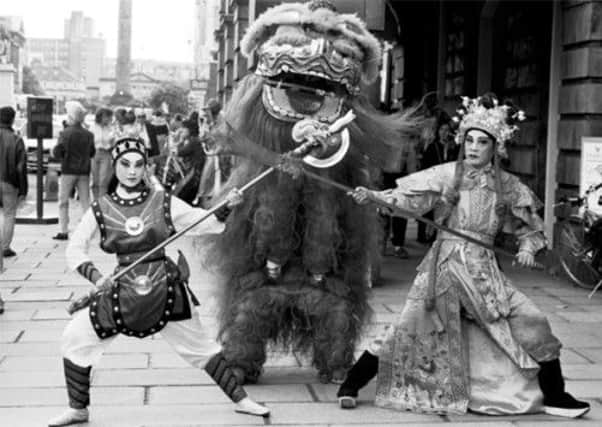The Edinburgh Fringe through the years


• Click through the gallery above to see archive images of the Fringe through the decades.
1947 - Eight theatre groups turn up uninvited to perform at the inaugural Edinburgh International Festival, which had been founded in the wake of World War II to promote international cooperation. Edinburgh was proposed as the setting by Henry Harvey Wood, who was based in the city working for The British Council, an organisation also founded to improve international relations through education and culture.
Advertisement
Hide Ad1948 – The Fringe gets its name when Scottish playwright and Evening News journalist Robert Kemp writes of it: ‘Round the fringe of official Festival drama, there seems to be more private enterprise than before ... I am afraid some of us are not going to be at home during the evenings!’
1951 – Edinburgh University students set up a drop-in centre giving Fringe performers cheap meals and a bed for the night; the first official organised facilities provided for the fledgling festival.
1954 - The first meeting between Fringe participants takes place, to discuss the possibility of working together on the logistics of the festival. The first Fringe programme is produced by C. J. Cousland, an Edinburgh printer.
1955 - Edinburgh University students set up a centralised Fringe box office and a café in a part of the Old College.
1958 – The Festival Fringe Society is created.
1960 - Alan Bennett, Dudley Moore, Peter Cook and Jonathan Miller perform at the Royal Lyceum Theatre in Beyond the Fringe, a production that ushered in a new age of British political satire. The show was actually part of the Edinburgh International Festival but its title, intended as a rebuttal to the growing Fringe, ironically helped publicise it.
1962 – Edinburgh University complains that their telephone system is struggling to cope with Fringe-related calls, when 34 groups show up to perform.
Advertisement
Hide Ad1966 - Tom Stoppard’s Rosencrantz and Guildenstern Are Dead, presented by the Oxford Theatre Group, is the Fringe’s first major world premiere.
1969 – The Festival Fringe Society becomes a limited company and is given charitable status.
Advertisement
Hide Ad1970 – The Fringe employs its first administrator, John Milligan, who held the position till 1976.
1973 - The Scotsman introduces the Fringe First awards, established by arts editor Allen Wright to encourage new theatre writing.
1981 - The number of companies performing rises to 494, making the Fringe officially the biggest arts festival in the world, an accolade it has retained ever since. The first Fringe Sunday, at which acts perform for free on the second Sunday of the Fringe, takes place on the Royal Mile. The Perrier Awards for Comedy are founded – performers with inaugural winners Cambridge Footlights include Stephen Fry, Hugh Laurie, Tony Slattery and Emma Thompson. Notable winners of the awards (which ceased their association with Perrier in 2006) have since included Frank Skinner, Sean Hughes, Steve Coogan, Lee Evans, Jenny Eclair, Dylan Moran, The League of Gentlemen, Al Murray and Rich Hall.
1983 – Thanks to its popularity, Fringe Sunday moves to Holyrood Park, where at its peak it attracts 40,000 people.
1988 – The Fringe Society moves from 170 High Street to its current home on the Royal Mile.
1992 – The Fringe operates its first computerised booking system.
Advertisement
Hide Ad1998 – The Fringe breaks ties with EIF by starting a week earlier, as productions found that by September audiences were dwindling, due to most people taking holidays in August.
2000 – The Fringe launches its website, making it the first arts organisation in the world to sell tickets online in real time. Over 4,500 internet bookings are made.
Advertisement
Hide Ad2002 - Amnesty International introduce the Amnesty Freedom of Expression Award, which recognises outstanding productions highlighting human rights issues.
2003 - Ticket sales top the one million mark for the first time.
2008 – Comedy overtakes theatre as the genre with the largest number of shows. In the Fringe’s annus horribilis, a new ticketing system fails, causing the Fringe an estimated £300,000 loss and leading to the resignation of Director Jon Morgan and Fringe Sunday is cancelled due to lack of sponsorship.
2011 - The Edinburgh Festivals Impact Study shows that the Fringe generates a total of £142 million for the Edinburgh and Scottish economies annually. According to the study, 89 per cent of Edinburgh respondents said the Fringe and other Festivals increase local pride in their home city.
2013 - The Edinburgh Festival Fringe 2013 features 45,464 performances of 2,871 shows (including 713 free ones and 1,585 world premieres) in 273 venues, with 24,107 performers from 41 countries taking part.